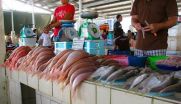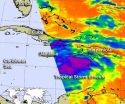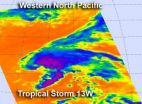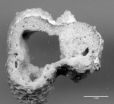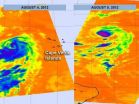(Press-News.org) (Santa Barbara, Calif.) –– Most people think of seafood as either wild or farmed, but in fact both categories may apply to the fish you pick up from your grocery store. In recent years, for example, as much as 40 percent of the Alaskan salmon catch originated in fish hatcheries, although it may be labeled "all wild, never farmed."
An article produced by a working group of UC Santa Barbara's National Center for Ecological Analysis and Synthesis (NCEAS) recommends that when a combination of seafood production techniques are used, this be acknowledged in the marketplace. The group calls on national and international organizations and governmental agencies to use the term "hybrid," when applicable. The article is in press with Marine Policy, and is currently available online.
"Farming fish and shellfish is generally a different way to produce seafood than fishing," said Dane Klinger, first author and a Ph.D. student at Stanford University. "While fisheries traditionally interact with their target population only at the time of capture, aquaculture, in its 'purest' state, controls the entire lifecycle of the organism, from egg to harvest. However, many common types of seafood are produced using techniques from both fisheries and aquaculture."
Mary Turnipseed, second author and a former postdoctoral fellow at NCEAS, commented: "Seafood production is a critical part of global food security, but the way we study and talk about it often obscures how to achieve the thing we care the most about: increasing the supply of sustainably produced seafood to feed a rapidly growing human population. We need to start collecting more accurate data on how seafood is really produced in today's world, and a first step will be through replacing the old farmed-fished dichotomy with a farmed-fished-hybrid classification scheme."
The article reveals how the strictly traditional categories of seafood production –– fisheries and aquaculture –– are insufficient to account for the growth potential and environmental impacts of the seafood sector. The authors examine several popular seafood products that are harvested using a combination of techniques generally ascribed to either fisheries or aquaculture.
The authors reviewed several cases of fisheries that are augmented by aquaculture. In addition to the example of hatcheries stocking Pacific salmon in Alaskan fisheries, hatcheries also stock scallops in New Zealand waters, and eastern oysters in the Chesapeake Bay, according to the authors. And American lobsters are fed by bait placed in traps until they reach legal catch size. In fact, the amount of bait provided to lobsters in one season is often greater than the volume of lobster catch in the same season, by a factor of two.
In aquaculture, the lines are often blurred –– fishing may be involved in production. For example, Bluefin tuna farms obtain their stock by fishing. These farms also fish for feed, and use 10 to 20 kilograms of fish for every kilogram of tuna they produce.
The primary source of information about the world's fisheries and aquaculture enterprises is the United Nation's Food and Agriculture Organization (FAO). However, the authors explain that the reporting of data from many developing and developed countries to the FAO is incomplete. They note that for the 52 percent of countries that do submit adequate data, "adding a hybrid production category would help elucidate their national understanding of domestic seafood production, as well as enhance global understanding of an important food sector."
The authors conclude by stating the urgency of adding the hybrid category: "Without these data, transformations in the market for a critical food and livelihood source for billions of people could occur, with global analysts and policymakers being the last to know."
The team responsible for the article, the NCEAS Working Group on Envisioning a Sustainable Global Seafood Market and Restored Marine Ecosystems, includes ecologists, economists, policy analysts, members of the seafood industry, and marine conservation organizations.
INFORMATION:
In addition to Klinger and Turnipseed, the authors are Benjamin S. Halpern, NCEAS; Kimberly A. Selkoe, NCEAS and the Hawaii Institute of Marine Biology; James L Anderson, University of Rhode Island; Frank Asche, the University of Stavanger, Stavanger, Norway; Larry Crowder, the Center for Ocean Solutions, Monterey, Calif.; Atle G. Guttormsen, Norwegian University of Life Sciences, Aas, Norway; Mary I. O'Connor, University of British Columbia; Raphael Sagarin, University of Arizona; Geoff Shester, Oceana, Monterey, Calif.; Martin D. Smith, Duke University; and Peter Tyedmers, Dalhousie University, Halifax, Nova Scotia.
Seafood, wild or farmed? The answer may be both
2012-08-07
ELSE PRESS RELEASES FROM THIS DATE:
Preschool children who can pay attention more likely to finish college
2012-08-07
CORVALLIS, Ore. – Young children who are able to pay attention and persist on a task have a 50 percent greater chance of completing college, according to a new study at Oregon State University.
Tracking a group of 430 preschool-age children, the study gives compelling evidence that social and behavioral skills, such as paying attention, following directions and completing a task may be even more crucial than academic abilities.
And the good news for parents and educators, the researchers said, is that attention and persistence skills are malleable and can be taught.
The ...
Critically ill uninsured Americans still at risk of being turned away from hospitals despite law
2012-08-07
Despite a twenty-five year old law that bans "patient dumping" the practice continues to put uninsured Americans at risk, according to a national team of researchers led by a professor at the George Washington School of Public Health and Health Services. Patient dumping is the practice of turning away or transferring uninsured patients with emergency medical conditions.
The study, which appears in the August issue of Health Affairs, suggests that hospitals still practice "patient dumping" which is in violation of the law. The researchers investigate and present five ...
New research studies policy divergence, voter polarization in elections
2012-08-07
CHAMPAIGN, Ill. — A study from University of Illinois economics professors demonstrates a new method to analyze the relationships among voters' issue preferences, the candidates' policy positions and voter behavior.
Estimating the distribution of voter preferences and the extent of policy divergence between the candidates' platforms, economics professors Stefan Krasa and Mattias Polborn are able to separate observed changes in voter behavior into those driven by voter radicalization versus those caused by increased policy differences between the two parties.
"We have ...
Poorest Americans at risk if states opt out of Medicaid expansion
2012-08-07
Health coverage for the poorest Americans could be in jeopardy in many states as a result of the U.S. Supreme Court's ruling last month on the Affordable Care Act, according to a new legal analysis. The report examines federal and state Medicaid options following the United States Supreme Court's ruling in NFIB v Sebelius and appears in the August issue of the journal Health Affairs.
"Some states will use the court's decision as an excuse to delay or refuse to participate in the expansion of Medicaid as outlined in the Affordable Care Act," says lead author of the report, ...
Forensic tools for catching poachers
2012-08-07
URBANA – The trade in ivory was largely outlawed in 1989, but poaching continues and remains a serious threat to the African elephant. Seizures of large amounts of ivory, sometimes over a ton, continue to occur. Research by Alfred Roca, an assistant professor at the university, could be the basis for the development of new law enforcement tools.
Roca has found a way to determine where the ivory comes from. With funding from the Division of International Conservation of the U.S. Fish and Wildlife Service, he and his collaborators have sampled elephants at 22 locations ...
Imagining how light behaves in a 2-D world gives researchers insights for faster 3-D rendering
2012-08-07
ZURICH — Though sophisticated three-dimensional imagery is abundant in computer-generated games and movies, a group of researchers from Disney Research, Zürich, University of California, San Diego, Limbic Software, and RWTH Aachen University say they have gained insights to improve the rendering of those images by envisioning a flat, two-dimensional world.
The fundamental physics of light is easier to understand in that 2D world than in a 3D environment, they said, and enabled them to develop simplified equations for governing the behavior of light. This in turn allowed ...
NASA sees a strengthening Tropical Storm Ernesto
2012-08-07
VIDEO:
An animation of satellite observations shows the progression of Tropical Storm Ernesto from Aug. 4-6, 2012. The animation begins when Ernesto was south of Jamaica and ends when the storm...
Click here for more information.
Tropical Storm Ernesto continues to track through the Caribbean and satellite data and NOAA hurricane hunter aircraft revealed a strengthening storm mid-day on Monday, August 6. NASA infrared data revealed strong thunderstorms on August 5 that ...
NASA's Aqua satellite shows strongest side of Tropical Storm 13W
2012-08-07
When NASA's Aqua satellite captured an infrared view of the northwestern Pacific's latest tropical storm, Tropical Storm 13W, the data revealed the bulk of the heavy rainfall on the northern side of the center.
NASA's Aqua satellite passed over Tropical Storm 13W on August 6 at 0205 UTC (Aug. 5 10:05 a.m. EDT). The Atmospheric Infrared Sounder (AIRS) instrument captured an infrared image of the cloud temperatures that showed the strongest storms (purple) and heaviest rainfall north and east of the center of circulation.
Infrared imagery shows temperature and the higher ...
Microbes, sponges, and worms add to coral reef woes
2012-08-07
Microbes, sponges, and worms—the side effects of pollution and heavy fishing—are adding insult to injury in Kenya's imperiled reef systems, according to a recent study by the Wildlife Conservation Society and the University of Azores.
The authors of the study have found that pollution and overfishing on reef systems have an ecological cascading effect—the proliferation of microbes, sponges, and worms—that further degrade corals, a discovery that underlines the complexity of reefs and possible solutions.
The study appears in the online edition of Marine Ecology Progress ...
NASA watches Tropical Storm Florence develop and weaken
2012-08-07
The sixth tropical storm of the Atlantic Ocean hurricane season formed over the past weekend, and NASA kept an on its progression. Tropical Storm Florence was born in the eastern Atlantic and weakened when it interacted with dry air.
On Friday, August 3, the low pressure area known as "System 90L" was being watched for development. It was located south of the Cape Verde Islands off the African coast. By the early evening (Eastern Daylight Time) it quickly organized. System 90L strengthened and became Tropical Storm Florence in the eastern Atlantic. Over August 4 and 5 ...
